Cause Lightning Number of deaths 19 Buildings destroyed 129 Burned area 8,400 acres (34 km2) | Fatalities 19 Start date June 28, 2013 Injuries 23 Location Yarnell | |
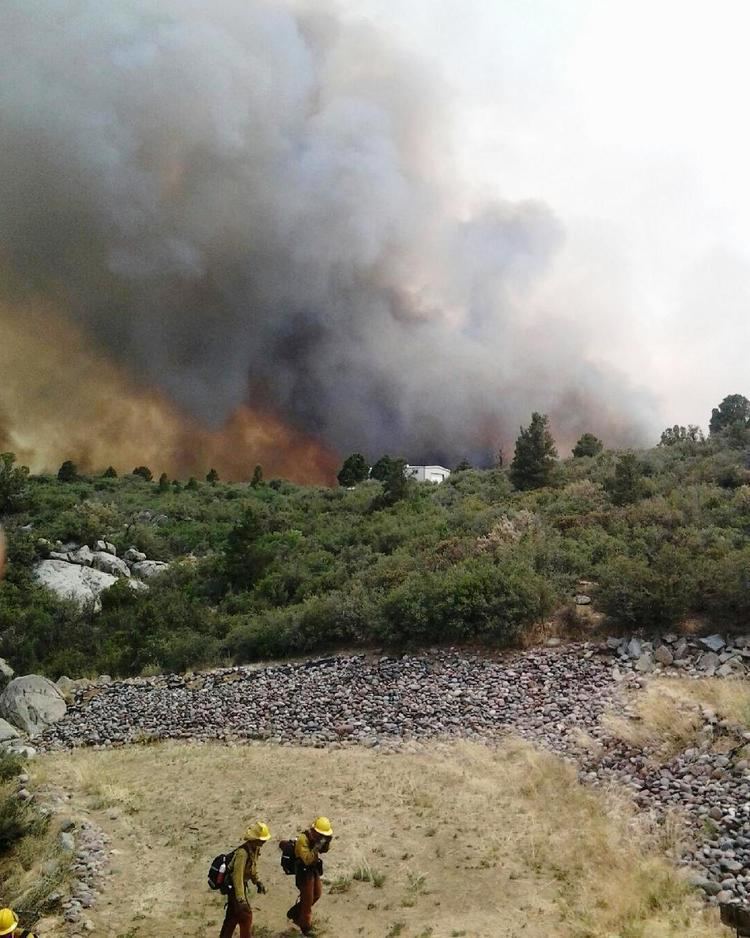 | ||
Similar Rim Fire, Wallow Fire, Black Forest Fire, Waldo Canyon Fire, Great Fire of 1910 | ||
2nd anniversary of the yarnell hill fire remembrance event june 28 2015
The Yarnell Hill Fire was a wildfire near Yarnell, Arizona, ignited by lightning on June 28, 2013. On June 30, it overran and killed 19 City of Prescott firefighters, members of the Granite Mountain Hotshots. This event resulted in the highest wildland firefighter death toll in the United States since the 1933 Griffith Park Fire killed 29 firefighters, and the highest death toll from any U.S. wildfire since the 1991 East Bay Hills fire killed 25 people. It is the sixth-deadliest American firefighter disaster overall and the deadliest wildfire ever in Arizona.
Contents
- 2nd anniversary of the yarnell hill fire remembrance event june 28 2015
- Yarnell hill fire report timeline of events
- Origin and development
- Effects
- Fatalities
- Reactions
- Aftermath
- References
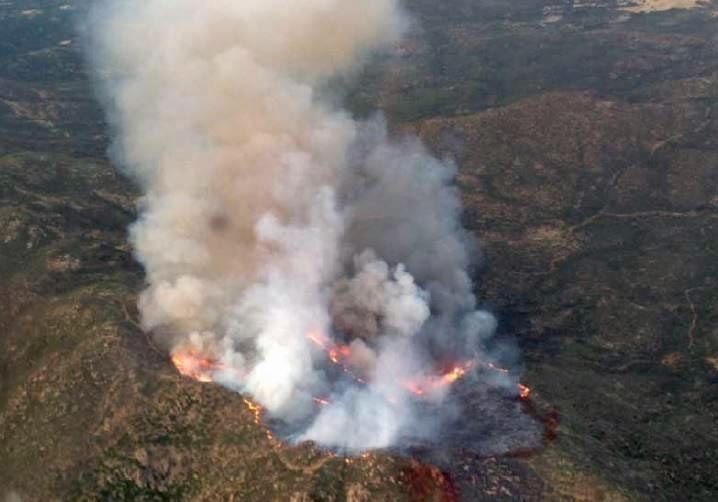
Yarnell hill fire report timeline of events
Origin and development
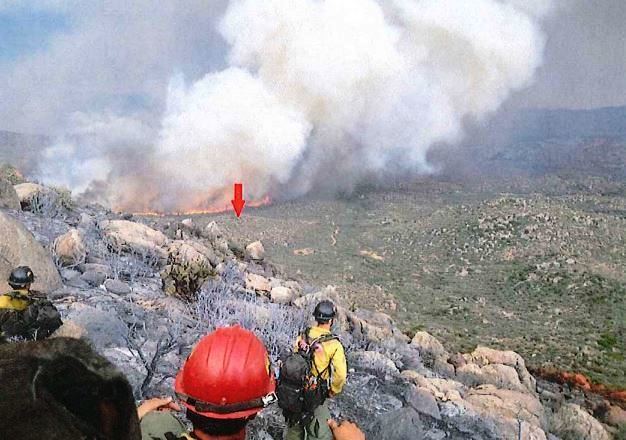
At 5:36 p.m. MST (23:36 UTC) on June 28, 2013, lightning ignited a wildfire on BLM lands near Yarnell, Arizona, a town of approximately 700 residents about eighty miles northwest of Phoenix. On June 30, strong winds reaching more than 22 mph (35 km/h), pushed the fire from 300 acres (120 ha) to over 2,000 acres (810 ha). A long-term drought affecting the area contributed to the fire's rapid spread and erratic behavior, as did temperatures of 101 °F (38 °C).
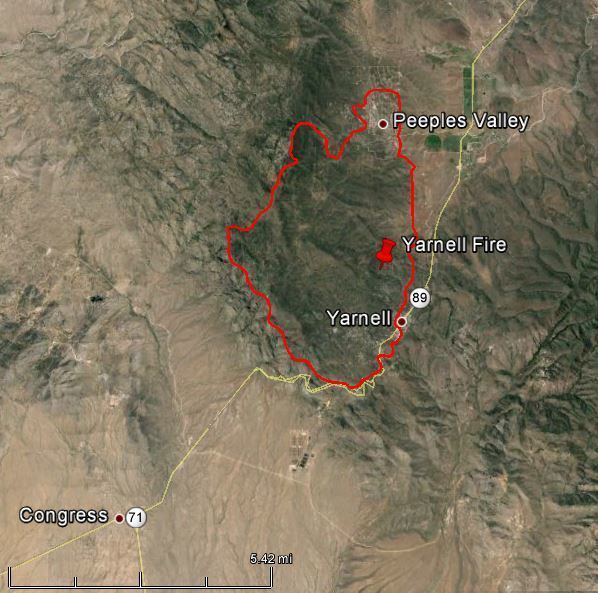
By July 1 the fire had grown to over 8,300 acres (3,400 ha) and prompted the evacuation of the nearby community of Peeples Valley. The fire was still completely uncontrolled, with more than 400 firefighters on the line. On July 2 the fire was estimated at 8 percent containment and had not grown in the past 24 hours. By the end of the day on July 3, the fire was reportedly 45 percent contained and not growing thus allowing Peeples Valley residents to return to their homes on July 4. Four days later on July 8 residents of Yarnell were permitted to return. The fire was declared 100 percent contained on July 10.
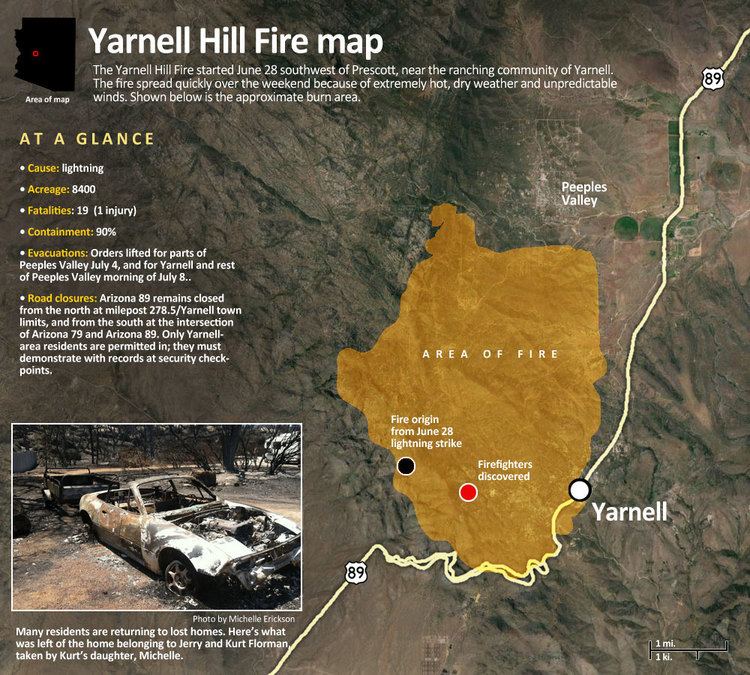
The Yavapai County Sheriff's Office said that 127 buildings in Yarnell and two in Peeples Valley had been destroyed. A "flash point" of the fire was the Glen Ilah neighborhood of Yarnell where fewer than half of the structures were burned.
Effects
Officials shut down 25 miles (40 km) of Arizona State Route 89 shortly after the fire started and 15 miles (24 km) of State Route 89 remained closed as of June 30. A total evacuation of Yarnell and partial evacuation of Peeples Valley was ordered. At least 600 people were under mandatory evacuation orders. An evacuation shelter was set up at Yavapai College in Prescott, with members of the Red Cross providing cots and blankets for overnight stays, along with meals and medical assistance. A second evacuation shelter was set up at Wickenburg High School in nearby Wickenburg because the closure of State Route 89 made it impossible for some people to reach the first shelter. Officials from The Red Cross said that 351 people spent at least one night at one of the shelters.
Fatalities
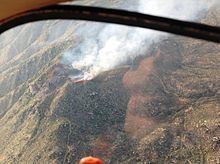
On June 30, 19 firefighters with the Prescott Fire Department's interagency Granite Mountain Hotshots were overrun and killed by the fire. Initial reports indicated that one of the firefighters was not a member of the hotshot crew, but Prescott Fire Chief Dan Fraijo later confirmed that all 19 were from the Granite Mountain Hotshots. The firefighters had apparently deployed fire shelters, but not all of the bodies were found inside them. The city of Prescott released the names of the 19 firefighters on July 1.
The lone survivor from the 20-man crew was 21-year-old Brendan McDonough. He had been serving as a lookout when the fire threatened to overtake his position. McDonough was about to deploy his safety shelter when he was rescued by Brian Frisby, the Superintendent of the Blue Ridge Hotshots, who was monitoring the radio communications between McDonough and the Granite Mountain IHC Captain. Frisby and McDonough moved the crew's vehicles to a safer location, which they were doing at the time of Granite Mountain crew entrapment. After moving the vehicles, Frisby and other members of the Blue Ridge Hotshots attempted to rescue the entrapped Granite Mountain Hotshots but were forced back by the intense flames and heat of the fire. Driving through the streets of Yarnell, the Blue Ridge Hotshots evacuated several residents who had failed to evacuate earlier. Frisby and his assistant eventually made their way to the entrapment site and were some of the first individuals to find the deployment site and the remains of the Granite Mountain crew.
According to the National Fire Protection Association, it was the greatest loss of life for firefighters in a wildfire since 1933, the deadliest wildfire of any kind since 1991, and the greatest loss of firefighters in the United States since the September 11 attacks.
Reactions
On June 30, Arizona Governor Jan Brewer issued a statement offering her condolences. "This is as dark a day as I can remember," she said. She ordered flags flown at half-staff in Arizona through July 19. President Barack Obama issued a statement on July 1, promising federal help and praising the 19 firefighters as heroes. Federal Emergency Management Agency spokesman Craig Fugate and United States Fire Administrator Ernest Mitchell issued similar statements on July 1. On July 2, members of the Arizona Cardinals visited one of the Red Cross shelters and the team president donated $100,000 to the 100 Club of Arizona, an organization that assists firefighters, police, and their families in crises. Authorities said that $800,000 had been raised for the families of the victims as of July 4.
On July 2, more than 3,000 people attended a public memorial service at an indoor stadium in Prescott Valley. Vice President Joseph Biden, Arizona Governor Jan Brewer, and the team's lone surviving firefighter, Brendan McDonough, spoke at a memorial in Prescott on Tuesday, July 9, 2013. That memorial was attended by thousands, including representatives from over 100 hotshot crews across the country, and was streamed live by several media outlets. Individual memorial services were scheduled for later in the hometowns of the 19 firefighters.
A flagpole has been placed at the deployment site where the 19 firefighters died; the site is not accessible to the public but can be seen from an overlook, adjacent to Highway 89 in Yarnell, which has been named the Granite Mountain Hotshots Memorial Overlook. A second memorial has been placed at the intersection of State Route 89 and Hays Ranch Road in Peeples Valley.
A nine-member investigative team of forest managers and safety experts arrived in Arizona on July 2; their mission is to "understand what happened as completely as possible" to prevent similar incidents.
The Arizona Diamondbacks of Major League Baseball began wearing a black patch with the number "19" on it in memory of the firefighters.
Aftermath
After the fire, the Federal Emergency Management Agency ruled that the fire does not qualify for disaster aid to homeowners because most of the homes that were burned had insurance. Under federal law, federal disaster relief is not available if there is insurance, and FEMA said "damage to uninsured private residences from this event was not beyond the response and recovery capabilities of the state (and) local governments and voluntary agencies." Brewer appealed to Obama to overturn the decision.
Following a three-month investigation, the state's Forestry Division released a report on September 28, 2013 which found no evidence of negligence or recklessness in the deaths of the 19 firefighters, and revealed that an airtanker carrying flame retardant was directly overhead as the firefighters died. The investigation did find some problems with radio communications due to heavy radio traffic and the fact that some radios were not programmed with appropriate tone guards.
On December 4, 2013, the Industrial Commission of Arizona, which oversees workplace safety, blamed the state's Forestry Division for the deaths of the 19 firefighters, based on an investigation by the state's Division of Occupational Safety and Health. The Commission said that state fire officials knowingly put protection of property ahead of safety and should have pulled crews out earlier. The commission levied a $559,000 fine.
